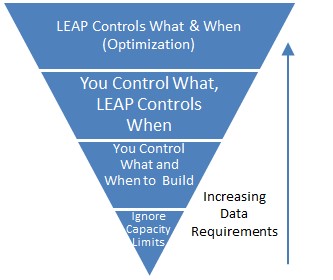Topic: Criteria used by LEAP in selecting technologies for generation expansion plans Subscribe | Previous | Next
2 Likes
This is an edited repost of a recent email Q&A..
Please clarify a couple of aspects regarding LEAP’s calculations. I need to understand the criterion/criteria LEAP uses in selecting the technologies to define generation expansion plans. I understood that LEAP can be used as an accounting or optimization framework.
1) How does LEAP decide how much capacity of each technology (gas, coal, solar, wind and biomass) will be installed? How does LEAP decide which technology to prioritize? Does the user tell LEAP what energy system they want to see built?
LEAP provides choices of methodologies to the user. Within its Transformation modeling subsystem, users can choose to do different kinds of accounting/simulation modeling as well as optimization approaches. You can even use different accounting approaches in one scenario and optimization in another scenario.
When using optimization, LEAP attempts to find the least cost organization of a particular sector (typically electricity generation) subject to various constraints. These constraints include (1) the need to meet energy demands, (2) optional emissions constraints for any particular pollutant (see below), (3) optional minimum and maximum levels of capacity for particular types of power plants, (4) optional maximum rates of capacity addition for particular types of power plants, and (5) minimum levels of generation from renewable power plants. The current version of LEAP can only optimize one particular sector, but the next major version will support full energy system optimization (similar to tools like TIMES, MARKAL and MESSAGE). LEAP’s optimization calculations are handled by the open-source NEMO optimization framework, that works with a range of solvers including free/open source solvers like CBC and HIGHs and “industrial strength” commercial solvers like CPLEX, GUROBI, MOSEK, and XPRESS.
When using accounting/simulation approaches, the user is again given choices of methods ranging from very simple methods that have low data requirements to more sophisticated methods. In the very simplest method, the user can tell LEAP to ignore capacity constraints and simple specify the share of generation coming from each type of power plant. In the more sophisticated methods the user separately specifies plant capacities and how they change over time as well as simulating the dispatch of power plants within the sub annual time slices that each year is divided into. Future capacity expansion can either be specified exogenously (useful for example if you simply want to take the results from some external study), or it can be calculated endogenously based on the need to maintain a planning reserve margin. Attached is an infographic that shows the basic choices a user gets when modeling capacity expansion in LEAP:
Plant dispatch can either be specified very simply (e.g., x% wind, y% solar, z% gas, etc.) or plants can be dispatched in proportion to their capacity and availability, by merit order, or in order of their running costs. Again, different methods can be simulated in different scenarios, and past historical periods can be set to simulate actual historical patterns of dispatch. LEAP has quite flexible time slicing that can reflect seasonal, type of day and time of day variations in demand and plant availability (e.g., hydro being more available in spring, solar only being available during day hours, etc.). Modeling of storage is also possible but is so far only supported when using optimization methods.
Accounting/simulation calculations are all built in. It’s also worth noting that LEAP includes an additional level of modeling capabilities used to specify each of its individual variables that makes use of a spreadsheet-like expression-based data definition language. For example, values for future capacity expansion pathways can themselves be modeled using LEAP’s built-in expression-based models, or linked to separate Excel spreadsheets that might contain additional modeling.
2) After the technology mix for each scenario is defined, LEAP can compare them in terms of GHG, cost and so on. Is this correct?
Yes, that’s right. LEAP can calculate the social costs of scenarios (NPVs) and can calculate GHG, SLCP and local air pollutant loadings. When doing national-scale modeling, these emissions can also be used to drive the IBC module that calculates population-weighted pollutant concentrations and health impacts in the form of premature mortality and years of life lost (YLLs). GHGs can be displayed individually or combined together to show overall global warming potential based on the GWP values recommended by the IPCC in their different assessment reports. LEAP currently supports GWPs from IPCC AR1..AR5. We will try to add the revised AR6 values soon.
3) Is it possible to define also minimization of GHG emission as objective function? Is it a multi-objective optimization framework?
LEAP/NEMO calculations are not multi-objective right now. Currently cost is the objective function, which is minimized subject to constraints (e.g. emission constraints). I must say I have long thought that it would be quite interesting to optionally set a cost budget and then have emissions minimization be the objective function. We have not done that yet, but you could do that yourself if you wanted to adjust the NEMO source code.

